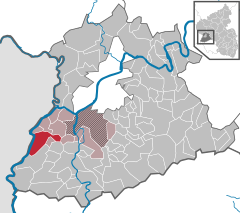|
Nittel
  Nittel (German pronunciation: [ˈnɪtl̩]; Luxembourgish: Nëttel [ˈnətəl]), on the Upper Moselle, is an Ortsgemeinde ("village municipality") in the Landkreis [county] of Trier-Saarburg in the state of Rhineland-Palatinate. It belongs to the Verbandsgemeinde [United Municipalities] of Konz. The place, located between dolomite and limestone cliffs, is a nationally recognized resort.[3] LocationNittel (without subdivisions: 1924 residents, 31 Dec 2008) lies 15 miles (24 km.) south of Trier on the Upper Moselle, which also forms the eastern boundary of Luxembourg. On the opposite side of the river are the Gemeinde [Municipality] of Wormeldange and the village of Machtum. On the Luxembourg side, the borough consists of the district of Rehlingen (180 inhabitants, 31 Dec. 2008), which lies in the south on the B 419 and, lying on the plateau, the predominantly agricultural district of Köllig (153 residents, 31 Dec 2008). Between Nittel and Onsdorf lies the lookout point, Höcht (1279.53 feet or 390 metres above sea level). HistoryThe area of the present Township of Nittel was proven to have been settled since the Stone Age. Numerous finds (pottery, belt buckles) provide the evidence of a Roman settlement from about 2,000 years ago. Nittel was mentioned for the first time with the name of Nitele in 1000 in a document by the Archbishop of Trier, Ludolf. A copy of the original can be found in the City Archives of Trier; it was exhibited during the ceremonies in 2000 at the city community in Nittel. The history of Nittel is several centuries long with numerous administrative changes and military conflicts. The Thirty Years War was a particularly bad time for the Upper Moselle river valley with occupations, murders, fires, pillage and famines. Nittlel itself belonged to the Duchy of Lorraine several times, to France several more times, and even Luxembourg (as a part of the Spanish and later Austrian Netherlands) a couple of times. The changes finally stopped in 1816, when the Congress of Vienna awarded Nittel to Prussia. Nittel became German at the end of World War I after the fall of Prussia. Köllig was first mentioned in 1030 as Coeltiche. The first documented evidence of the present community of Rehlingen was in the middle of the 12th century. The people of Nittel have lived for several centuries in the farms and vineyards. On 18 July 1946 Nittel, along with 80 other municipalities of the Counties of Trier and Saarburg, were assigned to the Saar Protectorate, which was no longer under the jurisdiction of the Allied Control Council. This arrangement did not last. 60 of those municipalities were sent to the newly formed state of Rhineland-Palatinate in 1946 and Nittel followed them on 8 June 1947. On 17 May 1974 the two formerly independent Gemeinden [municipalities] of Köllig and Relingen were merged with the Ortsgemeinde [Township] of Nittel.[4] Coat of armsThe coat of arms of the Gemeinde of Nittel, adopted in 1953, depicts a sword lying in the red upper half of the shield, in the silver lower half is a green mountain with a silver wavy line at its foot. PoliticsTown council
The town council of Nittel consists of 16 councillors, who were chosen in the municipal elections on 7 June 2009, according to the proportional representation method, and with the honorary mayor as the chairman. Distribution of the seats in the council after the elections:[5]
MayorSince 2019 Peter Leo Hein has been the Ortsbürgermeister ("[Township Mayor] of Nittel.[1] EconomyVinicultureNittel is the center of the cultivation of the Elbling wine in the Upper Moselle River. About 25 wineries cultivate vineyards with the total of 717 acres (290 hectares), of which the Elbling has the majority’s share with 75%. The limestone soil and the almost Mediterranean climate gives the local wines a nice touch, benefitting the white and pinot gris varieties. To Nittel belong the vineyards of “Rochusfels” [St. Roch on the Rocks], “Hubertusberg” [St. Hubert’s Mountain], “Leiterchen” and “Blümchen” [Little Flowers]. TourismIn Nittel there is a pier for the boating in the Moselle River. Hotels, restaurants and wineries with their wine bars and events are geared towards the tourists. Attractive for the visitors are a trail through the vineyards beneath the imposing wall of limestone, hiking in the 1,235 acres (500 hectares) of the municipal forest of Nittel, two nature reserves (Nitteler Fels [Nittel Rocks], where orchids bloom), the St. Rochus Chapel as well as the pond and recreation area, Eberthälchen [Little Boar Valley] Village Newspaper As the only legitimate town in the Upper Moselle Valley, Nittel is the home of the town's own newspaper, the “Darfscheel”, whose title is Moselle Franconian for “Village Bell”. The “Darfscheel” is a community newspaper for Nittel, the districts of Köllig and Rehlingen as well as the Luxembourg Machtum on the opposite side of the Moselle River. It is published three or four times a year with the circulation of about 1,500 copies. The newspaper is politically and economically independent. It is distributed free to all the households in Nittel, Köllig, Rehlingen and Machtum. All the employees and the authors are volunteers. On 29 October 2010 the “Darfscheel” was incorporated as a charitable organization with the name of “Darfscheel - Dorfzeitung Nittel eV” [Darfscheel - Town Newspaper of Nittel, Inc.].[6] The "Darfscheel" aims to report the events in the village to maintain the traditions, to promote a sense of community in the village and the clubs and to provide a forum for the dissemination of news. It wants to encourage the debates and to mediate on the disputes and so forth. But the newspaper is not the official bulletin of the district so there is not the obligation to reprint the official communications. Festivals and Events
Attractions 
Personalities
References
Literature
External linksWikimedia Commons has media related to Nittel.
|
||||||||||||||||||||||||||||||||||||||||||||||||||||||||||||||||||||||||||




